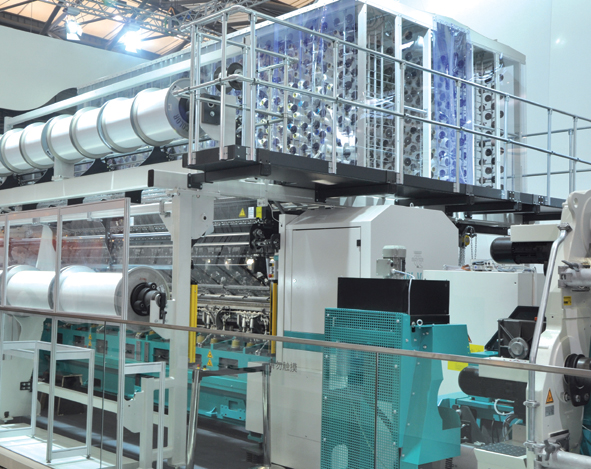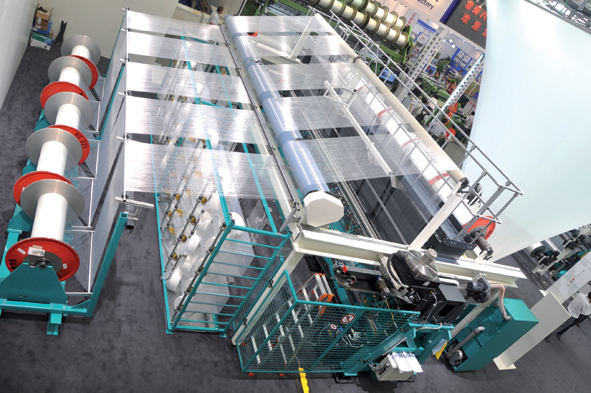Karl Mayer’s TM 4 T-EL
 When you are going on a beach holiday, you must remember one thing – a beach towel. These large terry textiles can be used as a soft surface to lie on. They also keep the sand away and create that special holiday feeling from the moment we begin to pack our suitcases. The new patterns now available means that this now applies more than ever before.
When you are going on a beach holiday, you must remember one thing – a beach towel. These large terry textiles can be used as a soft surface to lie on. They also keep the sand away and create that special holiday feeling from the moment we begin to pack our suitcases. The new patterns now available means that this now applies more than ever before.
Colour plays an important role when designing terry fabrics, but the structures are also becoming more and more important. Smooth edges, relief-like ribs and three-dimensional chessboard patterns increase the range of designs available and highlight the fluffy appearance of these loop-pile fabrics.
Karl Mayer has developed a new four-bar tricot machine, the TM 4 T-EL, to produce the various patterns efficiently, and this was successfully launched onto the market in June.
The technical concept
 With the introduction of the innovative TM 4 T-EL, Karl Mayer has extended its TM range by another machine for producing home and household textiles. Like its four-bar sister machine that does not have EL control, this new machine features modern drive technology and a new machine concept. All the main components have been harmonised to meet the needs of the customer, from yarn let-off through the knitting elements, to fabric take-down and batching.
With the introduction of the innovative TM 4 T-EL, Karl Mayer has extended its TM range by another machine for producing home and household textiles. Like its four-bar sister machine that does not have EL control, this new machine features modern drive technology and a new machine concept. All the main components have been harmonised to meet the needs of the customer, from yarn let-off through the knitting elements, to fabric take-down and batching.
An important step that was taken to meet the requirements of the market was to integrate electronic guide bar control (EL). In conjunction with the Kamcos motion control/multi-speed system, the EL-based technique of producing the patterns has enabled the existing design possibilities to be extended. The motion control system manages the electronically controlled yarn let-off, while the pattern control is responsible for controlling the ground guide bars.
The fabric take-down is also controlled electronically. This gives maximum flexibility during patterning. The parameters of the different designs can be input easily by using a touch screen. Data can also be transferred using a USB stick or via the company’s network.
The patterning advantages of the TM 4 T-EL are combined with a high level of productivity. This new terry machine can reach a maximum speed of 1,400 min-1.
Patterning possibilities and uses
The wide range of options available for designing single- or double-sided loop-pile products are the result of incorporating loop-free areas of any size at any location in both the lengthwise and crosswise directions. The EL control facility is responsible for producing the smooth areas in the horizontal direction. This technical feature also enables large repeats to be worked.
The vertical, flat stripes are produced by the relevant threading-in arrangement. This enables cord-like rib constructions, rectangular patterns in different sizes, and multi-coloured effects and edges at the end of the piece of fabric to be worked during the warp knitting process. The flat edges can be sewn to produce hems, or they can be used as an effective branding tool and embroidered with a trademark.
The simulations produced by Karl Mayer’s product developers show that the flat areas do not only run in a line but may also be arranged in a zigzag configuration or as a chessboard pattern. In this case, the loops can either be on one side or else not produced at all.
The TM 4 T-EL is particularly suitable for producing different articles sequentially. In addition to the wide range of patterns that can be produced, the loops are firmly anchored in, and the warp-knitted terry fabrics have a soft feel – characteristics that are not just opening up the market for high-end fleecy fabrics. In fact, these tough microfilament fabrics are also interesting for use as cleaning textiles. The structure of their materials and loop arrangement create a large area for tackling stains and removing even ingrained dirt. They can also be washed easily and dried quickly.
Market launch
The TM 4 T-EL was unveiled at ITMA Asia. The venue for this market launch was an in-house show held at Karl Mayer (China) Ltd. on June 14 to coincide with the exhibition. At this show, which was well attended, the new terry machine was showing its capabilities by producing various loop-pile products in sequence. Established Chinese producers of terry fabrics in particular were extremely interested in this new machine. This enabled some promising projects to be initiated and new business generated from the moment the machine went on sale.
For the further extension of its four-bar TM series Karl Mayer plans development of a TM 4-TS EL machine intended for cotton processing. The market launch of the newcomer is scheduled for the fourth quarter of 2013.
Available in large, small and now also in medium, the Wefttronic RS offers even more working widths
For some time now, raschel machines with parallel weft insertion have been among Karl Mayer Malimo’s best-selling machines. They mainly process high-strength polyester yarns to produce straight weft and zero inlays in 90° and 0° layers using three guide bars, and also sometimes two for special applications. The horizontal and vertical load-bearing yarns are fixed in line with the construction by the front guide bars. Products having a high tenacity and tear propagation resistance are mainly produced, and textiles having special characteristics can also be manufactured.
The weft-inserted fabrics may have dense constructions as well as lattice constructions with specific opening widths, and can have a range of weights from light- to medium- weight, depending on the requirements of the end-use.
Applications with high demands
The main end-uses of weft-inserted fabrics, which come in a variety of designs, are as advertising substrates and printed grounds, tarpaulins, protective textiles, awnings, abrasive elements and plaster grids.
 In general, competition is fierce on the markets for stable textiles. Any manufacturer who wants to be successful needs production machines which combine an exceptional price:performance ratio with a high product quality, are easy to operate, and offer a sufficient level of flexibility, thanks to their different working widths.
In general, competition is fierce on the markets for stable textiles. Any manufacturer who wants to be successful needs production machines which combine an exceptional price:performance ratio with a high product quality, are easy to operate, and offer a sufficient level of flexibility, thanks to their different working widths.
These requirements spurred Karl Mayer Malimo on to develop a completely new basic concept for its raschel machines with parallel weft insertion. The result of this extensive development work was the Wefttronic RS. This innovative range was unveiled for the first time at ITMA Asia, and its working width has been constantly expanded since then.
High efficiency and quality
The modifications in construction, which led to the development of the Wefttronic RS, focused mainly on increasing the speed and productivity. Consequently, the entire machine space and basic construction were adapted to the higher dynamics of the warp knitting process in order to increase the speed. In addition to increasing the production speed, the working width was also extended. This enabled the performance to be increased by up to 20 per cent.
Another improvement in efficiency offered by the new weft-insertion machine has been achieved by improving the components used in weft insertion. For example, the guide system of the circulating chain has been redesigned and the weft insertion system optimised. The weft carriage now contains 30 yarns instead of the previous 24.
The modified weft insertion system, with its half-inch spacing, also guarantees fault-free yarn laying without the yarns sticking together, which also increases the product quality. In order to produce a perfect textile, the entire yarn handling sequence on the machine was analysed and improved.
These changes in the construction resulted in uniform zero inlay run-ins in the delivery unit and at the guide rollers, thanks to central supports and short yarn paths for the knitting yarns in the ground guide bars.
Different working widths, greater flexibility
The recent developments have concentrated on complementing the range of working widths available. Whereas the first Wefttronic machine, which appeared in 2010, had a width of 268”, a version having a width of 138” was already available for ShanghaiTex 2011. A Wefttronic RS in a width of 213” was exhibited at ITMA Asia 2012. This intermediate width is complemented by a machine having a width of 176”, which was launched at the same time.
The different working widths of the Wefttronic RS for the simultaneous production of several fabric webs next to each other can be fully utilised to achieve a high level of operating efficiency.
All the technical features of the Wefttronic RS are housed in the space-saving machine configuration. The compact construction minimises floor space requirements and the short distances promote easy operation. Touchscreens for man-machine communication, the location of the ladder on the right-hand side of the machine, the drive, the patterning mechanism, and optimum width adjustment by a maximum of 60” round off the package of features that minimise the time and effort involved in operating the machine.
The Wefttronic RS can be integrated in the company’s own network or linked to the Internet to simplify data transfer. Linking the machine to the World Wide Web enables Karl Mayer’s Teleservice Plus to be accessed. Among other things, this service speeds up fault analysis and communication, and enables the service centre to access the machine on-site in real time.